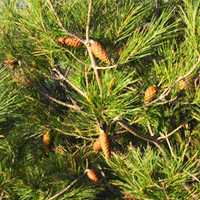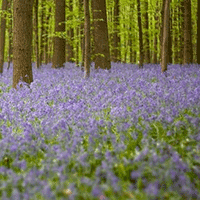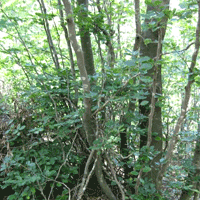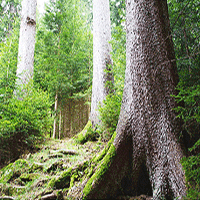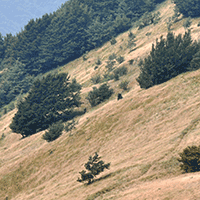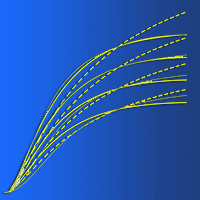
Importance of residual trees to birds in regenerating pine plantations
BB Hanberry (1) , P Hanberry (1), S Demarais (2), JC Jones (2)
iForest - Biogeosciences and Forestry, Volume 5, Issue 3, Pages 108-112 (2012)
doi: https://doi.org/10.3832/ifor0616-005
Published: Jun 05, 2012 - Copyright © 2012 SISEF
Research Articles
Abstract
Pine plantation establishment methods can alter vegetation composition and structure, thus affecting habitat important characteristics for declining early successional bird species. We evaluated eight vegetation characteristics, which varied due to a range of pine plantation establishment methods, to identify vegetation most closely associated with spring bird abundance in the Lower Coastal Plain of southern Mississippi, USA. Presence of residual trees and snags was positively related to relative abundance of 10 of 14 common species present in regenerating stands. Cover of woody vegetation was positively related to relative abundance of 4 species and negatively related to relative abundance of 2 species. For 5 species, increasing pine tree cover had a negative relationship with relative abundance. Residual trees and snags contributed to avian abundance and richness in regenerating pine plantations. Integration of habitat elements, such as residual trees that influence abundance of birds and other wildlife, with intensive pine plantation establishment can aid managers to attain wildlife conservation in intensively managed stands.
Keywords
Forest Management, Establishment, Habitat, Site Preparation, Snags
Authors’ Info
Authors’ address
P Hanberry
School of Natural Resources, 203 Natural Resources Building, University of Missouri, Columbia, MO 65211 USA
JC Jones
Department of Wildlife and Fisheries, Box 9690, Mississippi State University, Mississippi State, MS 39762, USA
Corresponding author
Paper Info
Citation
Hanberry BB, Hanberry P, Demarais S, Jones JC (2012). Importance of residual trees to birds in regenerating pine plantations. iForest 5: 108-112. - doi: 10.3832/ifor0616-005
Academic Editor
Marco Borghetti
Paper history
Received: Feb 01, 2012
Accepted: May 05, 2012
First online: Jun 05, 2012
Publication Date: Jun 29, 2012
Publication Time: 1.03 months
Copyright Information
© SISEF - The Italian Society of Silviculture and Forest Ecology 2012
Open Access
This article is distributed under the terms of the Creative Commons Attribution-Non Commercial 4.0 International (https://creativecommons.org/licenses/by-nc/4.0/), which permits unrestricted use, distribution, and reproduction in any medium, provided you give appropriate credit to the original author(s) and the source, provide a link to the Creative Commons license, and indicate if changes were made.
Web Metrics
Breakdown by View Type
Article Usage
Total Article Views: 60427
(from publication date up to now)
Breakdown by View Type
HTML Page Views: 48198
Abstract Page Views: 3127
PDF Downloads: 7486
Citation/Reference Downloads: 65
XML Downloads: 1551
Web Metrics
Days since publication: 4957
Overall contacts: 60427
Avg. contacts per week: 85.33
Citation Metrics
Article Citations
Article citations are based on data periodically collected from the Clarivate Web of Science web site
(last update: Mar 2025)
Total number of cites (since 2012): 15
Average cites per year: 1.07
Publication Metrics
by Dimensions ©
Articles citing this article
List of the papers citing this article based on CrossRef Cited-by.
References
Application of the line interception method in sampling range vegetation. Journal of Forestry 39 (4): 388-394.
Gscholar
Brown Thrasher (Toxostoma rufum). In: “The birds of North America: No. 557” (Poole A, Gill F eds). The American Ornithologists’ Union, Washington, DC, USA.
Gscholar
Snag management for cavity nesting birds. In: Proceedings of the workshop on “Management of Southern Forests for Nongame Birds” (DeGraaf RM ed). Gen. Tech. Rep. SE-14, USDA Forest Service, Asheville, NC, USA, pp. 120-128.
Gscholar
Snags are for wildlife. Proceedings of the “Symposium on Snag Habitat Management” (Davis JW, Goodwin GA, Okenfels RA technical coordinators). Gen. Tech. Rep. RM-99, Fort Collins, CO, USDA Forest Service, pp. 4-8.
Gscholar
The development of pine plantation silviculture in the southern United States. Journal of Forestry 105 (7): 337-47.
Gscholar
Eastern Towhee (Pipilo erythrophthalmus). In: “The birds of North America: No. 262” (Poole A, Gill F eds). The American Ornithologists’ Union, Washington, DC, USA.
Gscholar
Using statistical models to study temporal dynamics of animal-landscape relations. In: “Temporal dimensions of landscape ecology: wildlife responses to variable resources” (Bissonette JA, Storc I eds). Springer, New York, USA, pp. 93-118.
Gscholar
Birds and small mammals, intensively established pine plantations, and landscape metrics of the Coastal Plain. PhD Thesis, Department of Wildlife and Fisheries, Mississippi State University, Baton Rouge, USA, pp. 140.
Gscholar
White-eyed Vireo (Vireo griseus). In: “The birds of North America: No. 168” (Poole A, Gill F eds). The American Ornithologists’ Union, Washington, DC, USA.
Gscholar
The partners in flight handbook on species assessment. Version 2005. Partners in Flight Technical Series No. 3, Rocky Mountain Bird Observatory website.
Online | Gscholar
Assessment of counting techniques. In: “Current Ornithology: Volume 2” (Johnston RF ed). Plenum Press, New York, USA, pp. 247-302.
Gscholar
Scale problems in avian censusing. In: “Studies in Avian Biology 6” (Ralph CJ, Scott, JM eds). Cooper Ornithological Society, Lawrence, Kansas, USA, pp. 513-521.
Gscholar


